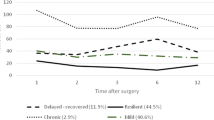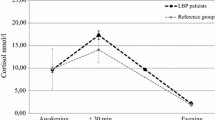Studies indicate that women fear breast cancer more than any other disease and that women’s levels of breast cancer-specific intrusions are related to their perceived risk of breast cancer. Here, we explore possible biological consequences of higher breast cancer risk perceptions and intrusions in healthy women without personal or family histories of the disease. We hypothesized that women with higher perceived risk would have more intrusions about breast cancer, which would constitute a background stressor sufficient to increase hypothalamus-pituitary-adrenal axis (HPA) responsivity to daily stress. HPA responses to an ordinary life stressor (work) were assessed in 141 employed women (age=37.2±9.2) without personal or family histories of breast cancer. Urinary cortisol excretion rates were assessed with timed sample collections at work, home, and during sleep. Repeated measures ANOVA revealed a significant Group by Time interaction with higher work cortisol levels in women with breast cancer-specific intrusions compared to women without intrusions (p < 0.02). Regression analyses revealed a significant association between risk perceptions and intrusions (p < 0.001). Regression analysis with intrusions and risk perceptions predicting work cortisol indicated a significant contribution of intrusions (p < 0.04), but not risk perceptions (p=0.53). Overestimation of breast cancer risk is associated with higher levels of breast cancer-specific intrusions that can result in increased cortisol responsivity to daily stressors. This heightened responsivity could have long-term negative health implications.

Similar content being viewed by others
REFERENCES
Cancer Facts and Figures 2005 (2005). American Cancer Society.
Baum, M. (2000). Epidemiology versus scare mongering: The case for the humane interpretation of statistics and breast cancer. Breast J. 6: 331–334.
Burke, W., Olsen, A. H., Pinsky, L. E., Reynolds, S. E., and Press, N. A. (2001). Misleading presentation of breast cancer in popular magazines. Eff. Clin. Pract. 4: 58–64.
Claus, E. B., Risch, N., and Thompson, W. D. (1994). Autosomal dominant inheritance of early-onset breast cancer. Implications for risk prediction. Cancer 73: 643–651.
Derogatis, L. R. and Spencer, P. (1982). The brief symptom inventory (BSI): Administration, scoring, and procedures manual-I. Baltimore: Copyrighted manuscript.
Dettenborn, L., James, G. D., van Berge-Landry, H., Valdimarsdottir, H. B., Montgomery, G. H., and Bovbjerg, D. H. (2005). Heightened cortisol responses to daily stress in working women at familial risk for breast cancer. Biol. Psychol. 69(2): 167–179.
Dickerson, S. S., and Kemeny, M. E. (2004). Acute stressors and cortisol responses: A theoretical integration and synthesis of laboratory research. Psychol. Bull. 130: 355–391.
Dudok deWit, A. C., Duivenvoorden, H. J., Passchier, J., Niermeijer, M. F., and Tibben, A. (1998). Course of distress experienced by persons at risk for an autosomal dominant inheritable disorder participating in a predictive testing program: An explorative study. Rotterdam/Leiden genetics workgroup. Psychosom. Med. 60: 543–549.
Elenkov, I. J., and Chrousos, G. P. (1999). Stress, cytokine patterns and susceptibility to disease. Baillieres Best. Pract. Res. Clin. Endocrinol. Metab. 13: 583–595.
Erblich, J., Bovbjerg, D. H., and Valdimarsdottir, H. B. (2000). Looking forward and back: Distress among women at familial risk for breast cancer. Ann. Behav. Med. 22: 53–59.
Erblich, J., Montgomery, G. H., Valdimarsdottir, H. B., Cloitre, M., and Bovbjerg, D. H. (2003). Biased cognitive processing of cancer-related information among women with family histories of breast cancer: Evidence from a cancer stroop task. Health Psychol. 22: 235–244.
Eskandari, F., and Sternberg, E. M. (2002). Neural-immune interactions in health and disease. Ann. NY. Acad. Sci. 966: 20–27.
Gaab, J., Blattler, N., Menzi, T., Pabst, B., Stoyer, S., and Ehlert, U. (2003). Randomized controlled evaluation of the effects of cognitive-behavioral stress management on cortisol responses to acute stress in healthy subjects. Psychoneuroendocrinology 28: 767–779.
Gail, M. H., Brinton, L. A., Byar, D. P., Corle, D. K., Green, S. B., Schairer, C. et al. (1989). Projecting individualized probabilities of developing breast cancer for white females who are being examined annually. J. Natl. Cancer Inst. 81: 1879–1886.
Gump, B. B. and Matthews, K. A. (1999). Do background stressors influence reactivity to and recovery from acute stressors? J. Appl. Soc. Psychol. 29(3): 469–493.
Hammerfald, K., Eberle, C., Grau, M., Kinsperger, A., Zimmermann, A., Ehlert, U. et al. (2006). Persistent effects of cognitive-behavioral stress management on cortisol responses to acute stress in healthy subjects—A randomized controlled trial. Psychoneuroendocrinology 31: 333–339.
Holleman, F., Endert, E., Prummel, M. F., van Vessem-Timmermans, M., Wiersinga, W. M., and Fliers, E. (2005). Evaluation of endocrine tests. B: Screening for hypercortisolism. Neth. J. Med. 63: 348–353.
Horowitz, M., Wilner, N., and Alvarez, W. (1979). Impact of event scale: A measure of subjective stress. Psychosom. Med. 41: 209–218.
Huizinga, G. A., Visser, A., Van Der Graaf, W. T., Hoekstra, H. J., Klip, E. C., Pras, E. et al. (2005). Stress response symptoms in adolescent and young adult children of parents diagnosed with cancer. Eur. J. Cancer 41: 288–295.
James, G. D., Berge-Landry, H. H., Valdimarsdottir, H. B., Montgomery, G. H., and Bovbjerg, D. H. (2004). Urinary catecholamine levels in daily life are elevated in women at familial risk of breast cancer. Psychoneuroendocrinology 29: 831–838.
James, G. D. and Brown, D. E. (1997). The biological stress response and lifestyle: Catecholamines and blood pressure. Annu. Rev. Anthropol. 26: 313–335.
James, G. D., Schlussel, Y. R., and Pickering, T. G. (1993). The association between daily blood pressure and catecholamine variability in normotensive working women. Psychosom. Med. 55: 55–60.
Joseph, S. (2000). Psychometric evaluation of Horowitz’s impact of event scale: A review. J. Trauma. Stress. 13: 101–113.
Kash, K. M., Holland, J. C., Halper, M. S., and Miller, D. G. (1992). Psychological distress and surveillance behaviors of women with a family history of breast cancer. J. Natl. Cancer Inst. 84: 24–30.
Katapodi, M. C., Lee, K. A., Facione, N. C., and Dodd, M. J. (2004). Predictors of perceived breast cancer risk and the relation between perceived risk and breast cancer screening: A meta-analytic review. Prev. Med. 38: 388–402.
Lerman, C., Daly, M., Sands, C., Balshem, A., Lustbader, E., Heggan, T. et al. (1993). Mammography adherence and psychological distress among women at risk for breast cancer. J. Natl. Cancer Inst. 85: 1074–1080.
Lipkus, I. M., Kuchibhatla, M., McBride, C. M., Bosworth, H. B., Pollak, K. I., Siegler, I. C. et al. (2000). Relationships among breast cancer perceived absolute risk, comparative risk, and worries. Cancer Epidem. Biomar. Prev. 9: 973– 975.
Lloyd, S., Watson, M., Waites, B., Meyer, L., Eeles, R., Ebbs, S. et al. (1996). Familial breast cancer: A controlled study of risk perception, psychological morbidity and health beliefs in women attending for genetic counselling. Br. J. Cancer 74: 482–487.
Lutgendorf, S. K., Reimer, T. T., Schlechte, J., and Rubenstein, L. M. (2001). Illness episodes and cortisol in healthy older adults during a life transition. Ann. Behav. Med. 23: 166–176.
Matthews, K. A., Gump, B. B., and Owens, J. F. (2001). Chronic stress influences cardiovascular and neuroendocrine responses during acute stress and recovery, especially in men. Health Psychol. 20: 403–410.
McEwen, B. S. (2000). The neurobiology of stress: From serendipity to clinical relevance. Brain Res. 886: 172–189.
McEwen, B. S., and Seeman, T. (1999). Protective and damaging effects of mediators of stress. Elaborating and testing the concepts of allostasis and allostatic load. Ann. NY. Acad. Sci. 896: 30–47.
McGregor, B. A., Bowen, D. J., Ankerst, D. P., Andersen, M. R., Yasui, Y., and McTiernan, A. (2004). Optimism, perceived risk of breast cancer, and cancer worry among a community-based sample of women. Health Psychol. 23: 339–344.
Montgomery, G. H., Erblich, J., DiLorenzo, T., and Bovbjerg, D. H. (2003). Family and friends with disease: Their impact on perceived risk. Prev. Med. 37: 242–249.
Olson, J. S. (2002). Bathsheba′s Breast: Women, Cancer, and History, The Johns Hopkins University Press, Baltimore, Maryland.
Parkin, D. M., Bray, F., Ferlay, J., and Pisani, P. (2005). Global cancer statistics, 2002. CA Cancer J. Clin. 55: 74–108.
Polk, D. E., Cohen, S., Doyle, W. J., Skoner, D. P., and Kirschbaum, C. (2005). State and trait affect as predictors of salivary cortisol in healthy adults. Psychoneuroendocrinology 30: 261–272.
Spittle, M. and Morgan, D. (1999). Women remain confused about breast cancer. BMJ 318: 600.
Sundin, E. C. and Horowitz, M. J. (2003). Horowitz’s impact of event scale evaluation of 20 years of use. Psychosom. Med. 65: 870–876.
Thewes, B., Meiser, B., and Hickie, I. B. (2001). Psychometric properties of the impact of event scale amongst women at increased risk for hereditary breast cancer. Psychooncology 10: 459–468.
Valdimarsdottir, H. B., Bovbjerg, D. H., Kash, K. M., Holland, J. C., Osborne, M. P., and Miller, D. G. (1995). Psychological distress in women with a familial risk of breast cancer. Psychooncology 4: 133–141.
Wear, D. (1993). Your breasts sliced off: Literary images of breast cancer. Women Health 20: 81–100.
Zakowski, S. G., Valdimarsdottir, H. B., Bovbjerg, D. H., Borgen, P., Holland, J., Kash, K. et al. (1997). Predictors of intrusive thoughts and avoidance in women with family histories of breast cancer. Ann. Behav. Med. 19: 362– 369.
Zakowski, S. G., Valdimarsdottir, H. B., Bovbjerg, D. H., Borgen, P., Holland, J., Kash, K. et al. (1998). Predictors of intrusive thoughts and avoidance in women with family histories of breast cancer. Ann. Behav. Med. 19: 362–369.
ACKNOWLEDGMENTS
This work was supported by grants from the Department of Defense Breast Cancer Research Program (Dettenborn, DAMD 17-03-1-0346; Bovbjerg, DAMD17-99-1-9303) and the National Cancer Institute (Bovbjerg, CA72457; Montgomery, CA105222). The authors would like to thank Dr. Gary Winkel for his thoughtful comments on the statistical analyses, Ms. Laurin Mack for her editorial assistance, the anonymous reviewers and the editor, Dr. Nash, for their thoughtful suggestions for improving the manuscript, and the study participants for their contribution of time and effort to the research.
Author information
Authors and Affiliations
Corresponding author
Rights and permissions
About this article
Cite this article
Dettenborn, L., James, G.D., Valdimarsdottir, H.B. et al. Breast Cancer-Specific Intrusions are Associated with Increased Cortisol Responses to Daily Life Stressors in Healthy Women Without Personal or Family Histories of Breast Cancer. J Behav Med 29, 477–485 (2006). https://doi.org/10.1007/s10865-006-9070-7
Accepted:
Published:
Issue Date:
DOI: https://doi.org/10.1007/s10865-006-9070-7




